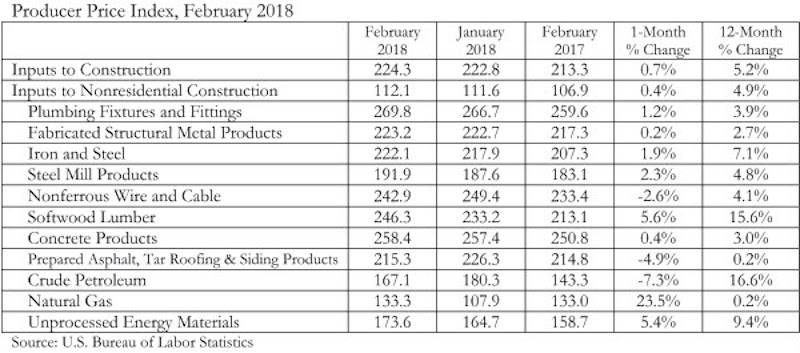Overall construction input prices rose 0.7% in February, slightly lower than the rate set in January, according to an Associated Builders and Contractors (ABC) analysis of Bureau of Labor Statistics data. Compared to February 2017, prices are up 5.2%. Nonresidential construction materials prices are also up 0.4% on a monthly basis and 4.9% compared to the same time last year.
Prices for all 11 subcategories increased year over year, and only three saw monthly declines. Crude petroleum saw the largest drop in price, falling 7.3% for the month, though it is up 16.6% on a year-over-year basis. Prices were also down for prepared asphalt, tar roofing and siding products (-4.9%) and nonferrous wire and cable (-2.6%). The largest monthly increase was in natural gas, which rose 23.5% in February. The rise in natural gas and drop in crude petroleum is a reversal of what was seen in January’s data.

“For the last several months, construction firms have become increasingly concerned about rising construction materials prices,” said ABC Chief Economist Anirban Basu. “Today’s data show those concerns are warranted. A confluence of factors will likely continue to push materials prices higher in the months to come. These factors include global monetary policy, which continues to help accelerate growth in much of the world, a strong U.S. construction market and a policymaking environment that has impacted the price of softwood lumber, steel and aluminum.
“Recently enacted tariffs are making headlines, but steel prices were already rising rapidly,” said Basu. “Based on today’s report, iron and steel prices rose 7.1% from February 2017 to February 2018. The price of steel mill products was up 4.8%, while the price of softwood lumber was up 15.6%.
“On top of materials price increases are, of course, expanding human capital shortfalls and rising compensation costs,” said Basu. “These factors have likely moderated near-term confidence among construction firms regarding profit margin growth in the midst of a healthy economy.”

Related Stories
Market Data | Jul 19, 2021
Construction employment trails pre-pandemic level in 39 states
Supply chain challenges, rising materials prices undermine demand.
Market Data | Jul 15, 2021
Producer prices for construction materials and services soar 26% over 12 months
Contractors cope with supply hitches, weak demand.
Market Data | Jul 13, 2021
ABC’s Construction Backlog Indicator and Contractor Confidence Index rise in June
ABC’s Construction Confidence Index readings for sales, profit margins and staffing levels increased modestly in June.
Market Data | Jul 8, 2021
Encouraging construction cost trends are emerging
In its latest quarterly report, Rider Levett Bucknall states that contractors’ most critical choice will be selecting which building sectors to target.
Multifamily Housing | Jul 7, 2021
Make sure to get your multifamily amenities mix right
One of the hardest decisions multifamily developers and their design teams have to make is what mix of amenities they’re going to put into each project. A lot of squiggly factors go into that decision: the type of community, the geographic market, local recreation preferences, climate/weather conditions, physical parameters, and of course the budget. The permutations are mind-boggling.
Market Data | Jul 7, 2021
Construction employment declines by 7,000 in June
Nonresidential firms struggle to find workers and materials to complete projects.
Market Data | Jun 30, 2021
Construction employment in May trails pre-covid levels in 91 metro areas
Firms struggle to cope with materials, labor challenges.
Market Data | Jun 23, 2021
Construction employment declines in 40 states between April and May
Soaring material costs, supply-chain disruptions impede recovery.
Market Data | Jun 22, 2021
Architecture billings continue historic rebound
AIA’s Architecture Billings Index (ABI) score for May rose to 58.5 compared to 57.9 in April.
Market Data | Jun 17, 2021
Commercial construction contractors upbeat on outlook despite worsening material shortages, worker shortages
88% indicate difficulty in finding skilled workers; of those, 35% have turned down work because of it.

















